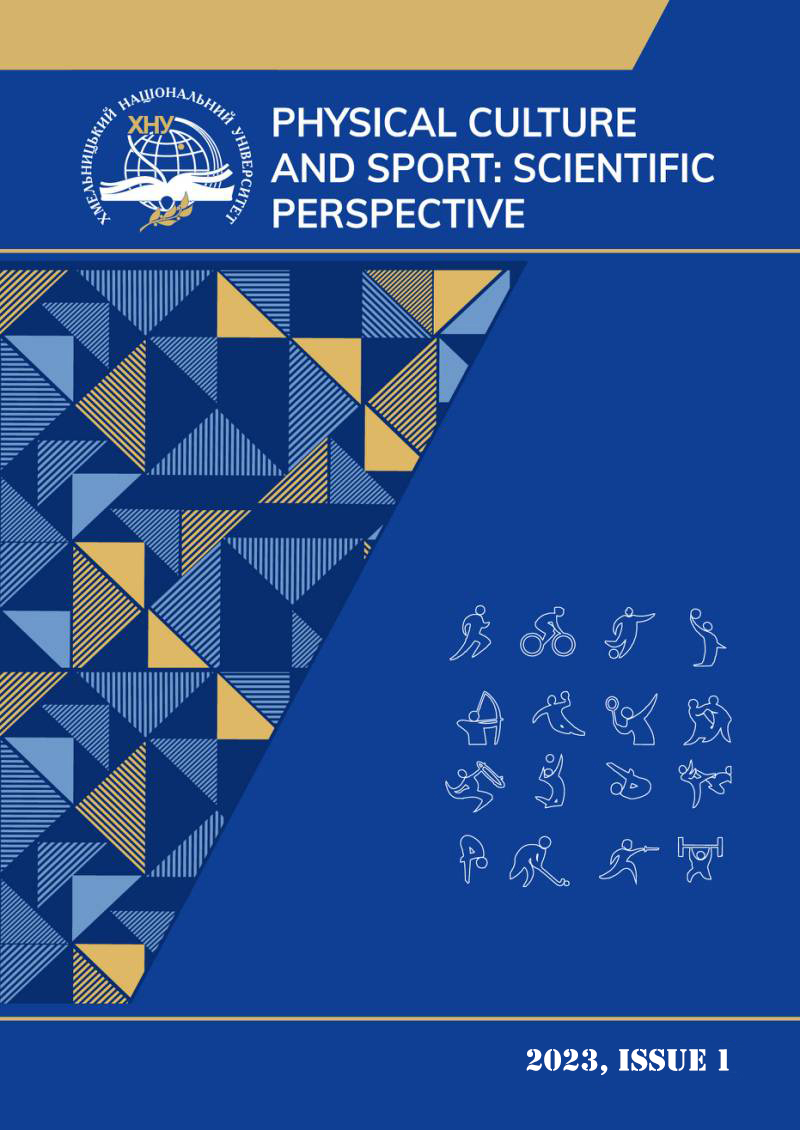DYNAMICS OF MOVEMENT ACTIVITY OF STUDENTS OF PRE-SCHOOL EDUCATION INSTITUTIONS
DOI:
https://doi.org/10.31891/pcs.2023.1.11Keywords:
physical culture and health activities, preschool education institutions, mobile games, health, physical cultureAbstract
The article presents the results of the study of indicators of students’ motor activity of Sumy region after the implementation of a complex of measures to optimize physical culture and health activities in the educational process of preschool education institutions. In today’s conditions, the issue of low indicators of students’ physical health of preschool educational institutions is a rather acute problem. Modern pedagogy and pediatrics sound the alarm about a change in the vector, in the direction of rejuvenation, of a whole series of diseases associated with education in kindergartens, due to a decrease in the amount of physical activity of students who, during the academic period, are engaged in preparation for the conditions of education in institutions of general secondary education. In this list we find the following diagnoses: defects of the musculoskeletal system, problems of the organs of vision, cardiovascular and respiratory systems, dermatological diseases, infectious diseases, etc. A decrease in the amount of motor activity of children during their stay in kindergarten leads to negative dynamics of physical fitness indicators, which contradicts the genetics and physiology of the development of future schoolchildren. It is also clear that due to absence from classes because of illness, regardless of its etymology, during the educational process, students will not receive the full amount of necessary knowledge for further education in institutions of general secondary education. It automatically leads to the problems with learning in the future. Another problem that negatively affects the motor activity of children is the indifferent attitude of educators to physical education classes with preference given to intellectual education. To solve the outlined problems, the author’s team has developed a complex of measures to optimize the process of physical culture and health activities of students during their stay in kindergarten. The complex is represented by game practices using sports and movement games that can be played during the educational process and at home outdoors.
References
Azhazha M. A., Gonda V., Nestorenko T. P. Chelovecheskyi kapytal: teoretycheskye osnovы y mekhanyzmы razvytyia. Problemy prostorovoho rozvytku sotsialno-ekonomichnykh system: ekonomika, osvita, medytsyna : monohrafiia. Opole : Akademiia upravlinnia ta administruvannia v Opolie, 2015. S. 63-69.
Bar-Or. O. Rouland T. Zdorove detei y dvyhatelnaia aktyvnost. K. : Olympyiskaia lyteratura, 2009. 528 s.
Havrylenko N. V. Ukraina i inkliuzyvne tsyfrove suspilstvo: shliakh do intehratsii. Materialy Mizhnar. nauk.-prakt. konf. "Vzaiemodiia norm mizhnarodnoho i natsionalnoho prava kriz pryzmu protsesiv hlobalizatsii ta intehratsii" (09.11.2022). Kyiv : vyd-vo SNU im. V. Dalia, 2022. S. 131–133. URL: http://eir.nuos.edu.ua/xmlui/handle/123456789/6476
Davydenko E. V. Metodyka fremynhemskoho issledovanyia dvyhatelnoi aktyvnosty cheloveka. K. : Olympyiskaia lyteratura, 1999. 12 s.
Krutsevych T. U., Bezverkhnia H. V. Rekreatsiia u fizychnii kulturi riznykh hrup naselennia: navch. posibnyk. K. : Olimp. l-ra, 2010. 248 s.
Moskalenko N. V. Borysova U. U., Sydorchuk O. U., Liadska T. V. Informatsiini tekhnolohii u fizychnomu vykhovanni. Dnipro : Innovatsiia, 2014. 127 s.
Tomenko O. A., Lazarenko S. A. Riven somatychnoho zdorovia i rukhovoi aktyvnosti studentiv vyshchykh navchalnykh zakladiv. Kharkiv : Slobozhanskyi naukovo-sportyvnyi visnyk. T.2, 2010. S. 17‒20.
Prokopova L. I., Chkhailo M. B. Kurs lektsiy z teorii i metodyky fizychnoho vykhovannia. Sumy : vydavnytstvo Vinnychenko M. D., 2009. 306 s.
Armstrong N., Kirby B., McManus A., Welsman J. Aerobic of prepubescent children. Ann Hum Biol 22: 427‒441, 1995.
Frost G., Bar-Or O. Dowling J. Explaining differences in the metabolic cost and efficiency of treadmill locomotion in children. J Sports Sci 20: 451–461, 2002.
Nestorenko T., Nestorenko O., Morkūnas M., Volkov A., Baležentis T, Štreimikienė D., Cai J. Optimization of Production Decisions Under Resource Constraints and Community Priorities. Journal of Global Information Management. 2022. Volume 30, Issue 12, 1-24. DOI: 10.4018/JGIM.304066. https://cutt.ly/BJuAo7U.
Ostenda A., Nestorenko T., Yemchenko I. The Suburbanization Process and Quality of Life. In Proceedings of the ITEMA 2019 Conference, Bratislava, Slovakia, 24 October 2019. School of Economics and Management in Public Administration, Bratislava, 235–240.





